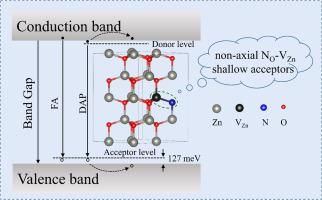当前位置:
X-MOL 学术
›
Appl. Surf. Sci.
›
论文详情
Our official English website, www.x-mol.net, welcomes your
feedback! (Note: you will need to create a separate account there.)
Non-axial NO-VZn Shallow Acceptor Complexes in Nitrogen Implanted p-type ZnO Thin Films
Applied Surface Science ( IF 6.3 ) Pub Date : 2020-11-01 , DOI: 10.1016/j.apsusc.2020.147168 Wanjun Li , Hong Zhang , Xiaoyu Zhang , Guoping Qin , Honglin Li , Yuanqiang Xiong , Lijuan Ye , Haibo Ruan , Cunzhu Tong , Chunyang Kong , Liang Fang
Applied Surface Science ( IF 6.3 ) Pub Date : 2020-11-01 , DOI: 10.1016/j.apsusc.2020.147168 Wanjun Li , Hong Zhang , Xiaoyu Zhang , Guoping Qin , Honglin Li , Yuanqiang Xiong , Lijuan Ye , Haibo Ruan , Cunzhu Tong , Chunyang Kong , Liang Fang

|
Abstract Over the past two decades, there have been numerous reports about the p-type behavior of N-doped ZnO. To date, however, its origin still remains mysterious, especially, N ion-implanted ZnO system. Herein, ZnO films were implanted with 70 keV N ions to a fluence of 1 × 1017 cm−2 at room temperature, followed by annealing in the range of 750–950 °C. The obtained p-type ZnO films have a widely hole concentration of 2.87 × 1015 ~ 2.64 × 1016 cm−3, a mobility of 1.37 ~ 7.27 cm2V-1s−1 and a resistivity of 148.3 ~ 299.4 Ω.cm. The thermal evolution of point defects and the possible shallow acceptors in N-implanted ZnO films were further investigated by means of Raman scattering, Photoluminescence (PL) and Electron paramagnetic resonance (EPR). The results show that abundant intrinsic-related defects including zinc interstitials (Zni), oxygen vacancies (VO) and zinc vacancies (VZn) were introduced during ion implantation. It is demonstrated that appropriate post-annealing can not only reduce the compensation of donor defects, but also facilitate the formation of N-related shallow acceptor complexes, both of which contribute to the p-type conduction transition of N-implanted ZnO films. The non-axial NO-VZn complexes are proposed to be a kind of potential and stable acceptors in N ion-implanted ZnO films.
中文翻译:

氮注入 p 型 ZnO 薄膜中的非轴向 NO-VZn 浅受体配合物
摘要 在过去的 20 年中,关于 N 掺杂 ZnO 的 p 型行为的报道很多。然而,迄今为止,它的起源仍然是个谜,尤其是 N 离子注入的 ZnO 系统。在此,ZnO 薄膜在室温下注入 70 keV N 离子至 1 × 1017 cm-2 的注量,然后在 750-950 °C 的范围内退火。获得的p型ZnO薄膜具有2.87×1015~2.64×1016cm-3的宽空穴浓度,1.37~7.27cm2V-1s-1的迁移率和148.3~299.4Ω.cm的电阻率。通过拉曼散射、光致发光 (PL) 和电子顺磁共振 (EPR) 进一步研究了点缺陷的热演化和 N 注入 ZnO 薄膜中可能的浅受体。结果表明,丰富的内在相关缺陷,包括锌间隙(Zni),在离子注入过程中引入了氧空位(VO)和锌空位(VZn)。结果表明,适当的后退火不仅可以减少施主缺陷的补偿,还可以促进与 N 相关的浅受主配合物的形成,这两者都有助于 N 注入 ZnO 薄膜的 p 型传导转变。非轴向NO-VZn配合物被认为是N离子注入ZnO薄膜中一种潜在且稳定的受体。
更新日期:2020-11-01
中文翻译:

氮注入 p 型 ZnO 薄膜中的非轴向 NO-VZn 浅受体配合物
摘要 在过去的 20 年中,关于 N 掺杂 ZnO 的 p 型行为的报道很多。然而,迄今为止,它的起源仍然是个谜,尤其是 N 离子注入的 ZnO 系统。在此,ZnO 薄膜在室温下注入 70 keV N 离子至 1 × 1017 cm-2 的注量,然后在 750-950 °C 的范围内退火。获得的p型ZnO薄膜具有2.87×1015~2.64×1016cm-3的宽空穴浓度,1.37~7.27cm2V-1s-1的迁移率和148.3~299.4Ω.cm的电阻率。通过拉曼散射、光致发光 (PL) 和电子顺磁共振 (EPR) 进一步研究了点缺陷的热演化和 N 注入 ZnO 薄膜中可能的浅受体。结果表明,丰富的内在相关缺陷,包括锌间隙(Zni),在离子注入过程中引入了氧空位(VO)和锌空位(VZn)。结果表明,适当的后退火不仅可以减少施主缺陷的补偿,还可以促进与 N 相关的浅受主配合物的形成,这两者都有助于 N 注入 ZnO 薄膜的 p 型传导转变。非轴向NO-VZn配合物被认为是N离子注入ZnO薄膜中一种潜在且稳定的受体。









































 京公网安备 11010802027423号
京公网安备 11010802027423号